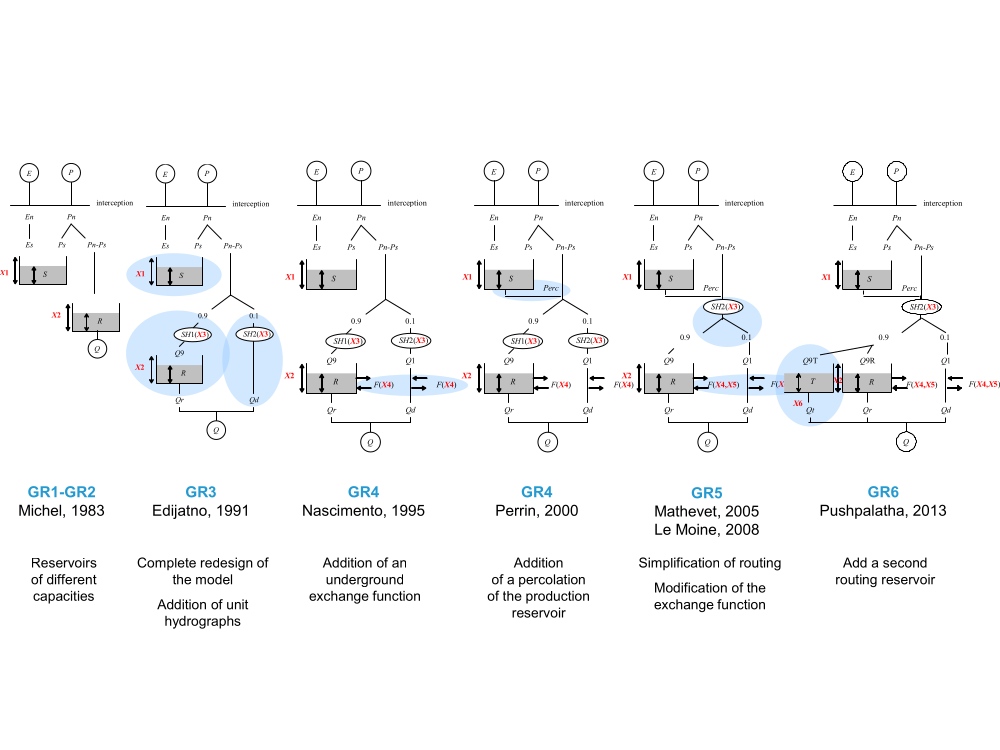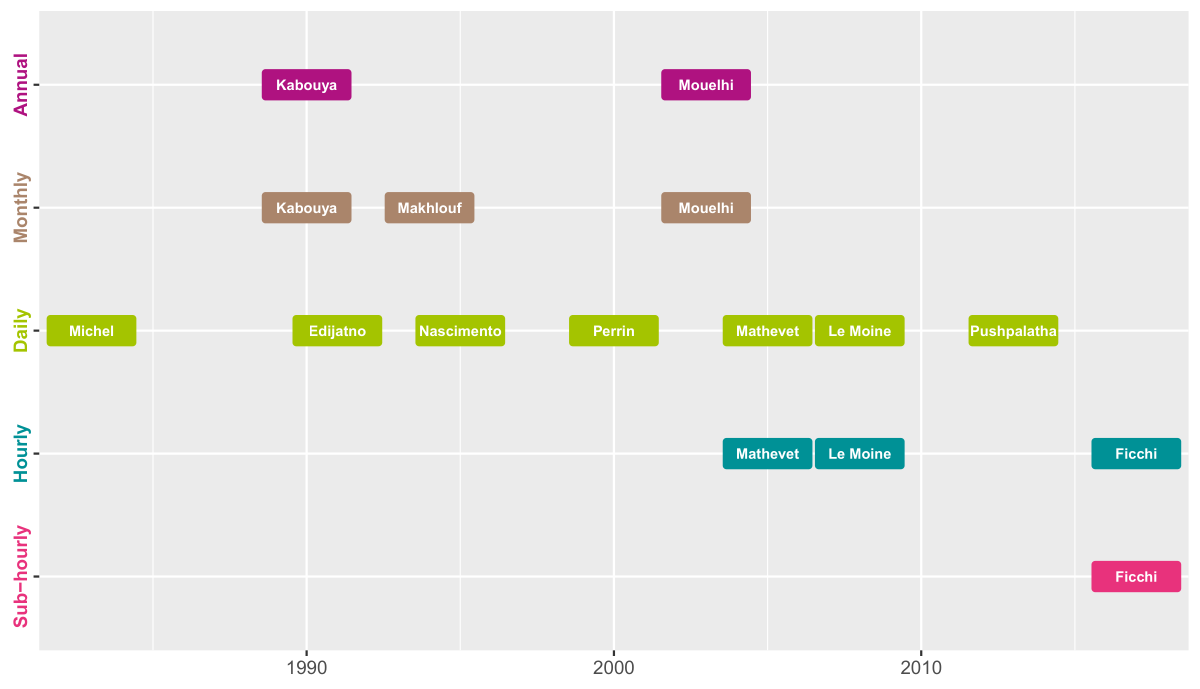In the following, we will distinguish:
- the works relative to the development of the annual and monthly rainfall-runoff models,
- the works relative to the development of the daily and hourly rainfall-runoff models,
- the works focusing on streamflow forecasting,
- the works focusing on accounting for soil moisture in the catchment,
- the works focusing on modelling of material fluxes (nitrates and suspended material).
N.B.: The historic presented is non exhaustive. For the sake of conciseness, the exact mathematical differences between the models are not given. These differences can be found in the references provided. Most of the works that are mentioned here were carried out at INRAE (Centre in Antony), but works from other teams that contributed to the development of the GR models are also evoked.
1. Monthly and annual models
The first attempts to model streamflows at a monthly time step with a simple rainfall-runoff model were made by Rifaat (1980) on the French Orgeval basin. Then, Kabouya (1990) set up the monthly GR3M model, which had 3 parameters, and applied it to the evaluation of water resources in Eastern Algeria (Kabouya et Michel, 1991). Makhlouf (1994) also worked on a monthly model and proposed a two-parameter model (Makhlouf et Michel, 1994), which was then improved by Mouelhi (2003).
At the annual time step, the works of Bouabdallah allowed establishing the basis of an annual rainfall-runoff model, with two versions, one with one parameter (GR1A) and one with two parameters (GR2A).
Then, Mouehli (2003) considered again the modelling chain at monthly, annual and multi-annual time steps, trying to identify how the structure of the models could adapt to the time step of the simulation. He searched for structural consistencies between the different time steps analysed. By doing this, he could propose a monthly model (GR2M) with two parameters (Mouelhi et al., 2006b) and an inter-annual model with no free parameter to calibrate.
2. Daily and hourly models
In the early 80’s, Claude Michel (1983) started a reflexion on the rainfall-runoff modelling approach of the CREC model, a nine-parameter model developed at the Hydrology lab of the University of Montpellier (Cormary et Guilbot, 1973). Starting from the structure of the CREC model, simplifications were made, in order to obtain a model with fewer parameters, without decreasing the performance of the initial model in terms of streamflow simulation. A simpler two-reservoir structure was then proposed and applied to the Orgeval catchment (Michel, 1983). This first model was a two-parameter daily model, GR2, with one parameter for each store.
Used by Loumagne (1988) and Devred (1989), this model was then modified again by Edijatno (1987, 1991) who, with a firmly empirical approach, improved its structure by modifying the production function and by adding a third parameter, a time constant of a unit hydrograph. The new daily model GR3 (Edijatno et Michel, 1989) was tested on 110 French catchments and gave satisfying results compared with some more complex models. Relationships between climatic indicators of the catchment and model parameter values could also be established.
With the aim of improving the structure of the GR daily models, Nascimento (1991, 1995) separated uneven catchments, for which the 3-parameter model failed to provide satisfying results, and introduced a fourth parameter governing the ‘groundwater’ exchanges to improve streamflow simulation. The new GR4 model led to better performances than the previous three-parameter version on a 120-catchment sample. In parallel with Nascimento (1995) works, Makhlouf (1994) led researches with the GR4J model on Mosel and Brittany catchments. Some clues for handling snow storage and melting in the model were evoked.
More recently, Edijatno et al. (1999) proposed a new version with three parameters of the daily model. This version, in which the maximum production reservoir capacity is fixed, is very similar to the one proposed by Nascimento (1995) with production and exchange functions that were slightly modified. Perrin (2000) and Perrin et al. (2003) proposed an improved version of this daily model, the GR4J model, which has four parameters and allows for improving low flow simulation with the introduction of a percolation term from the production store. This version was used by Mathevet (2005) who proposed a simplification of the routing, and then by Le Moine (2008) who introduced a five-parameter version (GR5J) with an improved water exchange function (that allows for inverting the signs of exchanges during the year). More recently, Pushpalatha (2013) proposed the introduction of a second routing reservoir for better low flow simulations, leading to a six-parameter version of the daily GR model (GR6J).
More recent developments introduced a robust snow module for the GR models (CemaNeige; Valery, 2010) and investigated a semi-distributed version of the models (Lerat, 2009 and Lobligeois, 2014).
3. Flow forecasting models
Another contribution of the rainfall-runoff modelling research carried out at INRAE focused on the more specific issue of streamflow prediction for flood and low flow forecasting.
The first works by Yang (1993), based on the Edijatno (1991) GR3 model at a finer time step, set up a flood forecasting method with model parameters updating.
Then, Tangara (2005) proposed a simpler method, based on a simplified version of GR4J model, allowing a direct updating of the routing store state variable of the daily model.
Real-time streamflow data assimilation for flood forecasting at an hourly time step was the subject of the research of Berthet (2010), who studied several data assimilation methods and proposed orientations for their use in real-time forecasting.
In parallel with the works by the Hydrology Team at INRAE in Antony, research was also carried out at INRAE in Aix-en-Provence to develop an event-based hourly version of the GR3 model. The focus was on streamflow forecasting in the Mediterranean area for flash flood alert and on poorly or ungauged basins.
Finally, the works of Bentura (1996) on flood propagation (Bentura and Michel, 1997), although not directly linked to the development of the GR models, showed that the routing used in GR3 could approach, in a satisfying way, the propagation results obtained from the Barré-Saint-Venant equations.
The hydrological models developed at INRAE, through their simplicity, correspond well to the aims of an operational use of the models. Consequently, the steps of development undertaken afterwards were dedicated to set up flood foreasting systems based on continuous rainfall-runoff modelling. The Oise, Ainse, Sarthe and Huisne river basins were the first basins in France where real-time flood forecasting systems were tested. The HYDROMATH software was developed in 2002, in collaboration with the consulting company SAFEGE, based on the joint use of a rainfall-runoff model and an updating procedure.Today, the GRP hourly model , developed in collaboration with the national service SCHAPI, is used in several flood forecasting centres (SPCs) in France.
The GRP model, in its daily or hourly version, is central to several research works that aim to improve:
- model updating for better handling the initial conditions of the catchments before launching real-time forecasts,
- early flood and inundation warning for public safety and property protection,
- inflow forecasting to water reservoirs for water management and decision-making,
- the prediction of snow-fed floods,
- the quantification of prediction uncertainties.
Whereas flood forecasting studies have focused on short lead-times (from some hours to some days), low flow prediction with GR models has focused on lead times of several weeks to months ahead. The probabilistic prediction is very relevant in this context. Low flow modelling and drought prediction are current research areas of the Hydrology team at INRAE in Antony.
4. Taking into account soil moisture in the catchments
The works in this domain were realised under the lead of Cécile Loumagne and Michel Normand, in collaboration with the « Centre d’Etudes Terrestres et Planétaires » (CETP) of Vélizy. The Orgeval and the Naizin catchments were used as test cases for the development of the models.
Starting from the simple two-parameter structure proposed by Michel (1983), the research of Loumagne (1988) focused on the use of soil moisture data for rainfall-runoff modelling. Based on observations revealing the importance of the soil moisture state of the surface layer for the production of streamflow in the catchment, her work investigated how to replace the production store in the model, which conceptually represented the soil, with measured soil moisture data.
This first approach gave promising results and was further investigated by Chkir (1996), who proposed the GRHUM model from the modification of the GR4 model: the production store was modified to obtain a two-layer store using the Deardoff scheme, the upper layer being intended at simulating the surface soil moisture of the catchment. This model could be used with or without assimilation of ground data.
This methodology was then used by Cognard-Plancq (1996) in collaboration with the CETP. It was shown that using post-processed remote sensing data resulted in a better evaluation of the catchment global humidity, which could then be used by the simulation model (Loumagne et al., 1996).
The European project Aimwater (Loumagne et al., 2002) focused on analysing the interest of soil moisture data from radar images for improving rainfall-runoff modelling for flood prediction. Image processing techniques (Quesney, 1999, Le Hegarat-Mascle et al., 2000, Quesney et al., 2000) and soil moisture data assimilation approaches were developed (Aubert et al., 2003, Weisse et al., 2002, 2003), in connection with previous works of Yang (1993) on flood prediction.
5. The modelling of material fluxes: transfer of pollutants and suspended material
Under the leadership of Thierry Leviandier, research works were oriented towards modelling the transfer of pollutants and suspended material (MES) using the GR models.
In order to model nitrate agricultural pollution, Ma (1991), based on the results from the Edijatno and Michel (1989), worked on the GR3 model and added a third store to this model’s structure. This store aimed at « routing » the percolation from the soil store. It was added to improve low flow simulation and to allow the coupling of the GR model to a model for the production and transfer of nitrate. A daily five-parameter model (GR5) was developed. The application to the Mélarchez catchment (Orgeval) provided good results, but the modelling exercise proved to be more difficult on larger river basins. The works of Mantilla Morales (1995) showed however good performance of the GR5 model for simulating the transfer of nitrate on the Charente catchment.
When participating to works initiated by Leviandier (1993) in the multi-disciplinary research program Piren-Seine, Gafrej (1993) explored the modelling of suspended material (MES) on the Marne basin using scale invariances in hydrological transfers in the catchment. Following these works, Kribèche (1999) further investigated the use of the MHR model coupled to a MES model. By taking into account spatial variabilities, it was possible to link model parameters to the physical properties of the studied catchments.
Zermani (1998) and Leviandier et al. (1994) also considered the catchment spatial heterogeneity in the simulation of nitrate transfers. The use of GIS allowed linking the parameters of conceptual models to the main physical characteristics of the studied catchments. The works provided a conceptual solution to consider spatial variability in the modelling framework.
The family of the GR hydrological models – Interview with Charles Perrin and Vazken Andréassian




